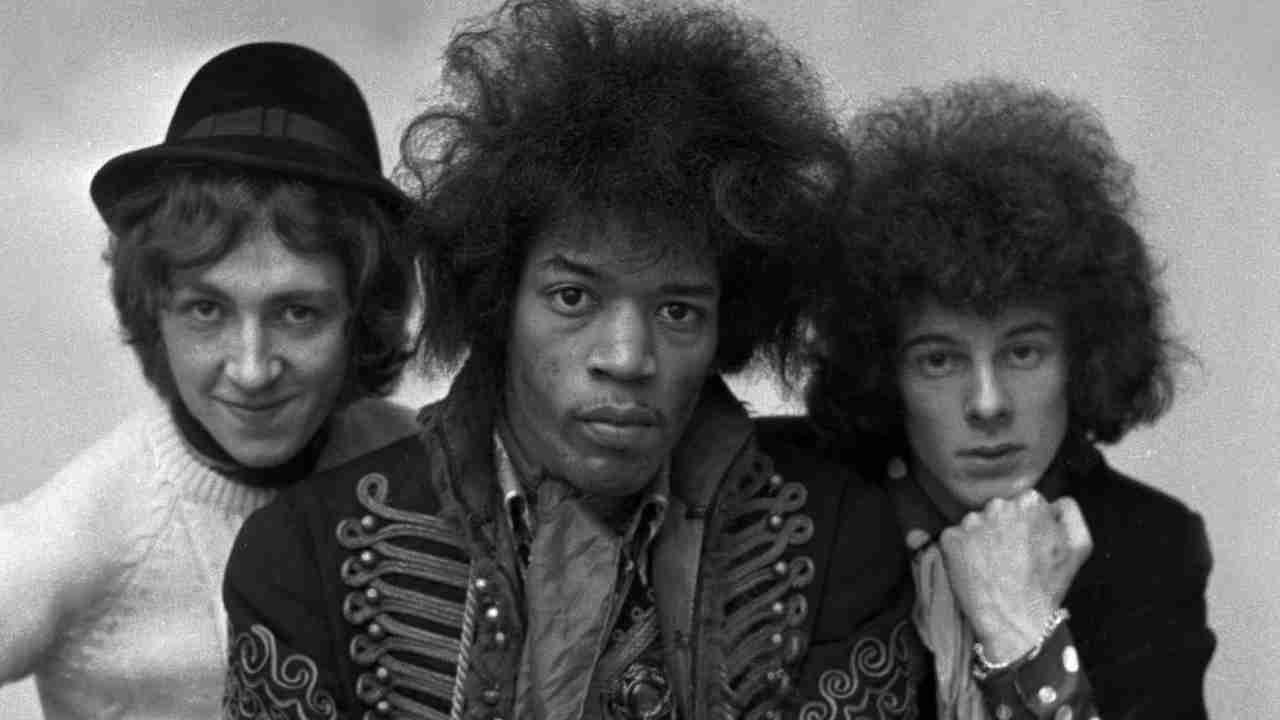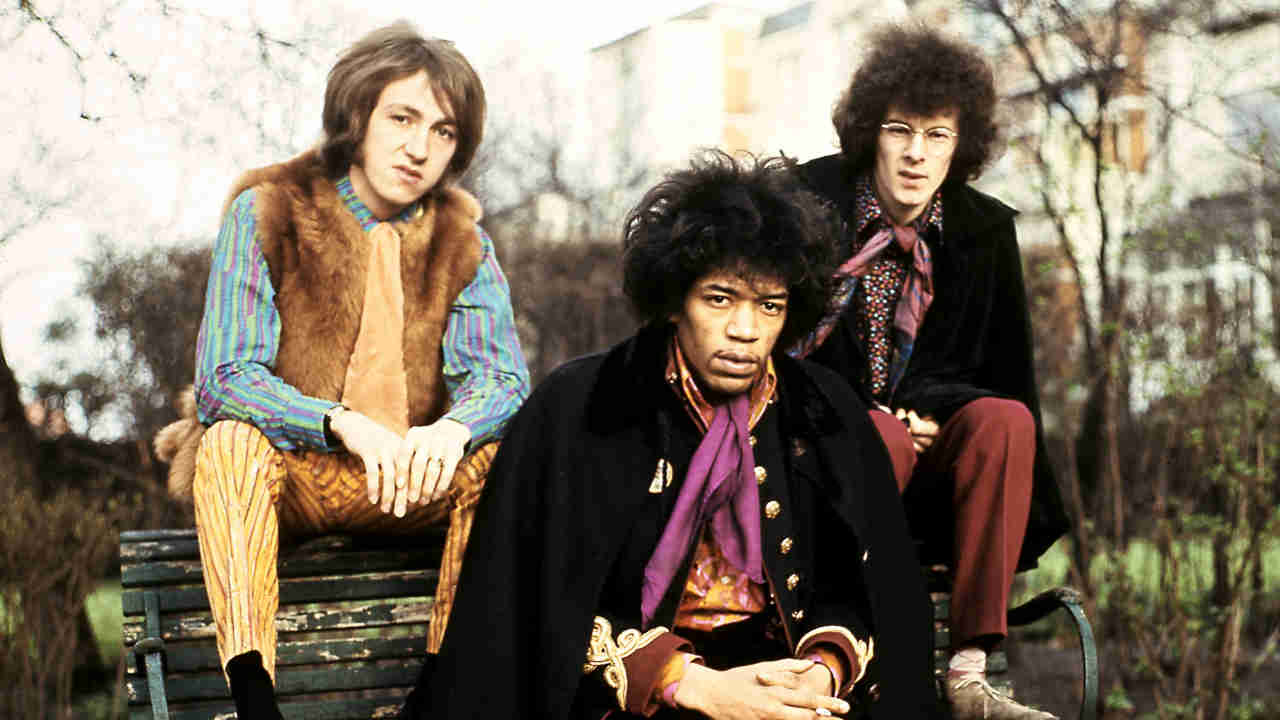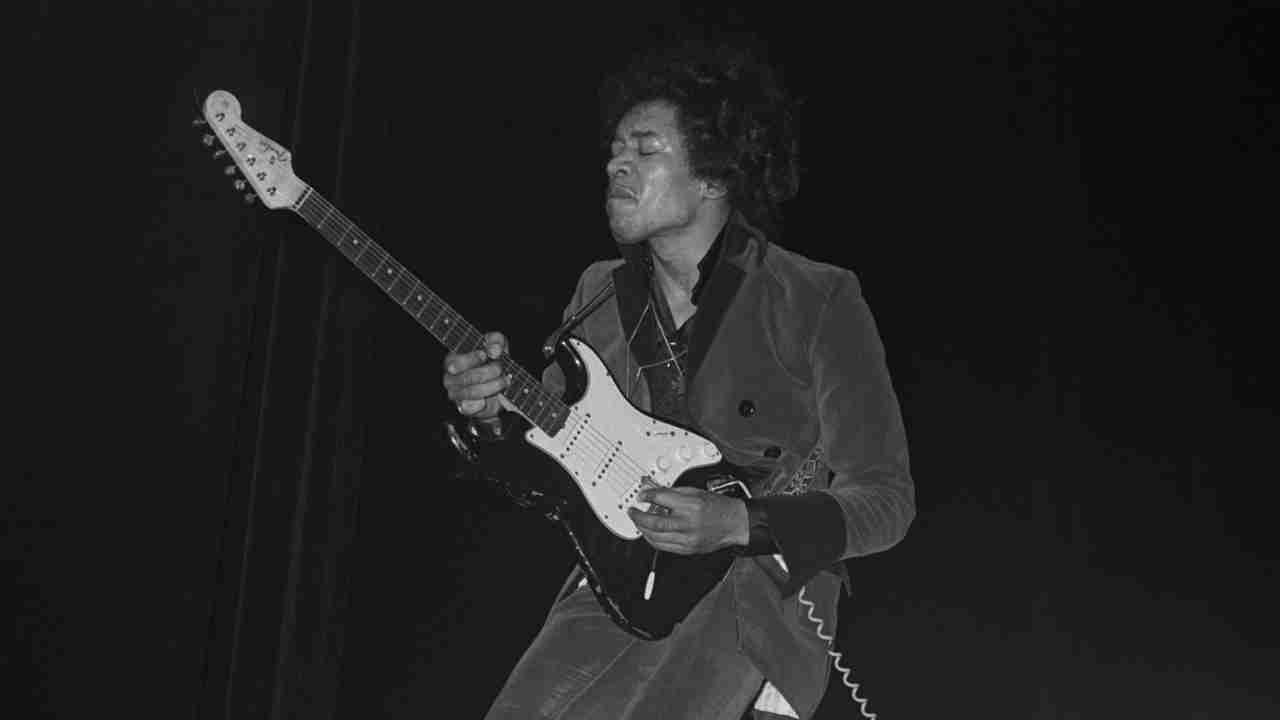“It gets tiring doing the same thing. In this life, you gotta do what you want, you gotta let your mind and fancy flow free”: The epic story of Jimi Hendrix’s Axis: Bold As Love, the heart of the guitarist‘s Holy Trinity
The story of Axis: Bold Of Love, Hendrix’s “science fiction rock’n’roll” masterpiece

If you were to write a science fiction novel set in the year 1967, it would be hard to imagine a more captivating cosmic messenger than Jimi Hendrix. With a wild afro that looked like a shock of electrical wires, psychedelic duds streaked with hues from the Crab Nebula and a strange language that was part-philosophical rambling, part screaming Stratocaster, he came to London, dropping jaws wherever he went. And since aliens always arrive on earth with a manifesto to help humanity, Hendrix’s was called, with futurist bravado, Axis: Bold As Love.
He’d already grabbed everyone’s attention early that year with his band The Experience’s debut Are You Experienced. So the second album seemed the ideal vessel for a message. Axis was recorded in fits and starts amidst a hectic tour schedule that included over 180 international dates (including package outings with such strange bedfellows like The Monkees and Englebert Humperdinck), many TV appearances, and a landmark appearance at the Monterey Pop Festival. It was seen by Hendrix’s manager Chas Chandler and Jimi’s labels Track in the UK and Reprise in the US as a quick follow-up release, a way to keep the conversation going with fans and critics. Considering it was followed less than a year later by Jimi’s double-album masterwork Electric Ladyland, it’s not surprising that Axis has suffered from a kind of middle child syndrome. But middle children can go to extremes to get attention, and this one often sounded like it was tuned to a radio station on another planet.
Not to belabor the extraterrestrial, but Hendrix even described the album as “science fiction rock ‘n’ roll,” and on the opener Up From The Skies, he sings from an alien’s point of view: “I wanna know about the new mother Earth, I wanna hear and see everything.” That fascination was there from his childhood. As a boy, Jimi claimed he saw a UFO, and he was obsessed with TV show Flash Gordon, even insisting that his family call him “Buster,” after the serial’s star Buster Crabbe.
“Science Fiction is about the only thing I read,” Hendrix said in 1966. During his globe-trotting 1967, he was devouring genre classics like Earth Abides by George Stewart, Gulf by Robert A. Heinlein and Secret Places Of The Lion: Alien Influences On Earth’s Destiny by George Hunt Williamson. All those novels share a common theme of genius secret societies who try to save humanity by improving communication. And Jimi’s concept of the “Axis” was similar – a freeway from earth to space to infinity, a “living form of energy, music and love,” a way to give people direct feeling and deeper understanding.
Indeed, the lyrics throughout the album often seem as if they’re written in some trippy new language, aiming for higher purpose. As he sang on the almost-title track Bold As Love: “Anger he smiles towering shiny metallic purple armour/Queen jealousy, envy waits behind him/Her fiery green gown sneers at the grass ground/Blue are the life giving waters taking for granted.”
Musically, the album is full of textured static, noise blasts and layered guitars processed with ethereal phasing, echo effects and backwards tapes. Hendrix may have just wanted to “wave his freak flag high, high,” but the altitude initially bewildered listeners.
“I’m glad there is this kind of reaction,” the 24-year old guitarist told the NME. “Maybe it’s a little murky in there, a bit smoky, but it’s the kind of disc youput down and go back to. When I first heard Procol Harum’s A Whiter Shade Of Pale, the meaning was very muddy. I understood about the first verse and that was all. But as you hear it again and again you begin to put the thing together. We’ve tried to get most of the freaky tracks right into another dimension so you get that sky-effect, like they’re coming down out of the heavens.”
Sign up below to get the latest from Classic Rock, plus exclusive special offers, direct to your inbox!

The first sessions for Axis: Bold As Love took place at Olympic Sound in early May. Over two nights, with Chas Chandler producing and Eddie Kramer engineering, the Experience cut rough shapes for If 6 Was 9, Up From The Skies, She’s So Fine and four other songs. Kramer gave this writer a glimpse into the trio’s creative approach in the studio.
“Everything was a jam first, then he would develop ideas into songs,” he said. “That’s the genesis of how Jimi worked on every album. Riffing, riffing, riffing, going over stuff with Mitch and Noel, stretching it out, putting other stuff back in, taking stuff out. That was the process.”

From constant touring, the trio was mind-meldingly tight, able to leap off into flights of improvised fancy. Nowhere is that more evident than in the track Bold As Love, which achieves an almost Sun Ra-like controlled chaos. “There’s one point in that song where we’re playing three different rhythms at the same time,” Noel Redding once said. “Most of those things were worked out in the studio.”
Though stakes were high for The Experience, Jimi had ways of keeping things light during sessions. “He was very flippant and acerbic, but very deep and thoughtful too,” says Kramer. “He would take the piss out of me and Mitch and Noel. Then he would take the piss out of himself with self-deprecating humor. If we were in the studio, and all of a sudden a track was going south, bam, without even missing a beat, he would launch into The Batman Theme or Peter Gunn or any of the TV themes that were popular at the time. Everybody would laugh and relax, then we’d get right back into the song again.”
An often-overlooked member of the Axis team was Roger Mayer. Jimi nicknamed him “The Valve” (after an amplifier vacuum tube) and praised Mayer as “their secret weapon.” By day an acoustic engineer for British Admiralty, he was a classic boffin - pasty complexion, lank hair, brilliant mind. He’d already invented fuzz boxes and effects pedals for Jimmy Page and Jeff Beck. But after being “blown away” by Jimi’s performance at the Bag O’Nails, Mayer dedicated himself almost exclusively to helping the guitarist realize the far-out tones that floated through his mind.
“Both Jimi and I had synaesthesia, where we would see colours in sound,” Mayer told Music Radar in 2017. “We found that fascinating. It’s a useful ability as a sound designer. I was very interested in new sounds for guitars. We would talk about the vision of the sound. For instance: ‘This sounds like what you see when you hold two mirrors in front of each other.’ And that notion became The Octavia pedal.”
As the name of that pedal suggested, Mayer was a fellow sci-fi enthusiast. “The sounds of the record could be thought of as bunch of disks floating in space in front of you, like flying saucers with sounds coming from them and they’re moving around,” he recalled. “And the song Castles Made Of Sand was partly inspired by some of the books we were reading, like Dune by Frank Herbert. It’s a science fiction kind of fantasy, but really down to earth in a way. Jimi was very good at depicting imagery that people could relate to, but with a bit of a cosmic twist to it, you know?”
While the spacey sounds burbled through Castles…, You Got Me Floatin’ and If 6 Was 9, the most perfect blend of extraterrestrial and earthly was on Little Wing, surely one of Jimi’s greatest songs. Of the inspiration for the latter ballad, he said: “I figured that I take everything I see around, and put it maybe in the form of a girl and call it ‘Little Wing,’ and then it will just fly away.”
He later told his brother Leon that the song was about their mother Lucille. Whoever the subject, more than half a century and countless spins on, it’s still breathtaking and fathoms deep. Those hammered Curtis Mayfield-style guitar chords, the mystical lyric, the tender vocal, the swirling aria-like solo.
“His rhythm guitar playing on that was stupendous,” says Kramer. “His sense of timing was always immaculate. Even when Mitch was floating the beat around like a jazz cat. His ability to be able to play lead and rhythm at the same time. If you isolate the rhythm guitar track on anything by Jimi, you’ll always get the whole essence of the song wrapped up in one performance.”
Recording continued on the trio’s rare off-days through the summer, bookended by more touring and two noteworthy shows. On June 4, at the Saville Theater, Hendrix opened his set with a roaring cover of Sgt. Pepper’s Lonely Hearts Club Band, complete with a feedback-laden solo. The Experience had learned it backstage 30 minutes before going on. Jimi spun the record on his portable player for Noel and Mitch and said, “We’re starting with this.”
“It took balls to do that,” Kramer says. “Paul McCartney was there, and he couldn’t believe it. The record had just come out that week.” Though Hendrix admired many of his musical contemporaries, he held Dylan and The Beatles in highest regard. And the experimentalism of Pepper definitely inspired him to push his own boundaries on Axis.
The other highlight was the Monterey Pop Festival, where The Experience stole the show from The Who and The Grateful Dead , making their first major impact in the US. Jimi, in antique military coat and feather boa, pulled out all of his tricks, playing with his teeth, behind his back and between his legs, coaxing out a joyous electric maelstrom before the 90,000 people. Noel Redding summed it up: “We destroyed the place. We just nailed it. That made the band in America.”
In the midst of the touring and sessions for Axis, there was a curious episode that illuminates something essential about Jimi’s nature. In August, on a two-day break in New York City, he met up with his old bandmate, singer-guitarist Curtis Knight. Hendrix played Knight some rough mixes from the album. “I’m really getting into something now,” the guitarist said.

The pair wanted to go out to dinner, but Hendrix was broke. Knight suggested that Jimi might borrow some money from Ed Chalpin, the producer/label owner who in 1965 signed Jimi to a contract with a one-dollar advance, then later tried to sue him to stop the first Experience album from coming out. The three had a late-night dinner, and then incredibly, Jimi went to the studio with Chalpin and cut six songs. “You can’t put my name on these,” he told the producer.
Chalpin later said Jimi was friendly that night, with no mention of the legal battles from the year before. What’s clear from this incident is that first, Jimi always lived in the moment, and when the moment was about music, any business considerations and complications simply went out the window. The resulting tangled webs, coupled with his impulsive, freewheeling nature, would come back to haunt him constantly through his brief life. Jimi wasn’t naive. But he was always a creator first, and a businessman third.
“There were two sides there,” says Kramer. “Jimi was savvy about what was going on, but he also had a big heart.”
He could also be a bit absent-minded. It seems the making of every classic record includes some narrowly avoided mishap. As Axis neared the finish line in October, Jimi lost the master reel of mixes for Side One, leaving it in the back seat of a London taxi. Chandler and Kramer had to remix the entire seven-song sequence from scratch overnight. But they couldn’t match their lost mix of If 6 Was 9. Noel Redding had a well-worn, crinkled backup tape, which Kramer had to press flat inch by inch with an iron.
For the album’s iconic gatefold sleeve, Track and Reprise decided that, unlike their debut album, there would be one cover design for the UK and US. They latched onto the Indian craze that was buzzing sympathetically through the music scene in ‘67. Thanks to The Beatles association with Ravi Shankar and Maharishi Mahesh Yogi, sitars and day-glo Nehru jackets were everywhere. A black and white photo of The Experience, snapped by Kal Ferris, was rendered by painter Roger Law over top an iconic Hindu religious work called Viraat Purushan-Vishnuroopam.
While Jimi appreciated the bright colours and many-beings-as-one concept, he didn’t like the cover initially. “You got it wrong, I’m not that kind of Indian,” he said, wishing they’d honored his own Cherokee roots. Nevertheless, it has become one of the most reproduced images of the ’60s, gracing shirts, posters and memorabilia.
The album, which cost a whopping £10,000 to make – including £3,000 for the cover alone – was released on December 1, 1967. Critical reaction was mixed. “Uneven in quality” said Rolling Stone. “A vivid listening experience” was the measured take from Record Mirror. Meanwhile, Melody Maker (who said, “Amaze your ears, boggle your mind”) and NME (“It’s the answer in how you might convey colour to a blind man”) seemed to grasp the album’s questing sci-fi spirit. While it went Top 5 in the UK and US, the jazzy lead single Up From The Skies failed to chart.
Though the labels and Chas Chandler were surely displeased with the lack of singles, it had the effect of subtly freeing Hendrix from the pop treadmill. Noel Redding would soon leave the band to pursue his own career with Fat Mattress, while Mitch Mitchell stuck around for another year. The only permanent members of the creative team for the next three years were Roger Mayer and Eddie Kramer. “There was nothing we wouldn’t do, or that we wouldn’t want to try for him,” Kramer said. “The rules were, there were no rules.”
And so Axis, for all its middle child status, not only deserves more attention for its music and artistic merit, but for how it played the essential role of switching Jimi onto a course of exploration rather than pop star repetition. As he told the New York Times in 1968: “It’s a different record. Like I do one thing and they say: ‘That’s good – that’s great.’ Then I say, ‘Well, how about this then?’ and they say, ‘Yeah, that’s a number one,’ so I do something else. I’m trying to get new things all the time.
“We’ll keep moving. It gets tiring doing the same thing, coming out and saying, ‘Now we’ll play this song,’ and ‘Now we’ll play that one.’ People take us strange ways, but I don’t care how they take us. Man, we’ll be moving. In this life, you gotta do what you want, you gotta let your mind and fancy flow, flow, flow free.”
Originally published in Classic Rock Presents Jimi Hendrix
Bill DeMain is a correspondent for BBC Glasgow, a regular contributor to MOJO, Classic Rock and Mental Floss, and the author of six books, including the best-selling Sgt. Pepper At 50. He is also an acclaimed musician and songwriter who's written for artists including Marshall Crenshaw, Teddy Thompson and Kim Richey. His songs have appeared in TV shows such as Private Practice and Sons of Anarchy. In 2013, he started Walkin' Nashville, a music history tour that's been the #1 rated activity on Trip Advisor. An avid bird-watcher, he also makes bird cards and prints.



